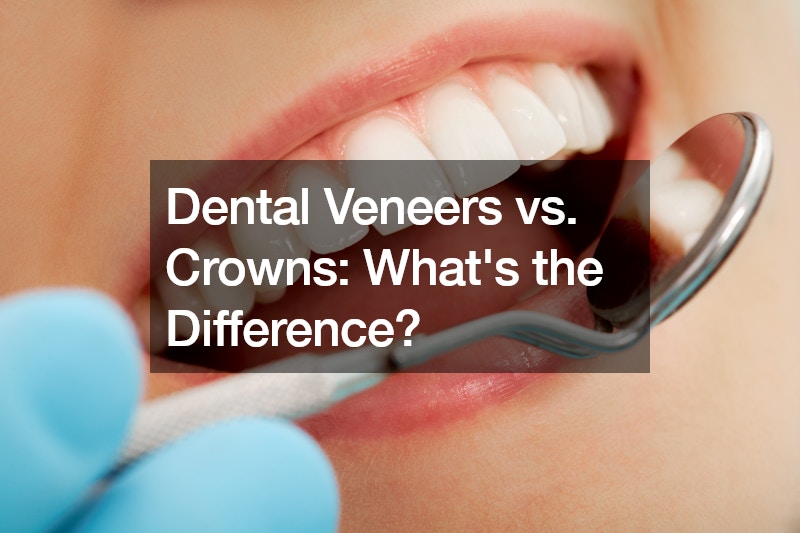
Are you considering improving your smile through cosmetic dentistry? If so, you might have come across the terms “veneers” and “crowns.” These are two common procedures used by dentists to restore or enhance the appearance of teeth. But what exactly are the differences between veneers and crowns? Let’s explore each option to help you make an informed decision about which might be right for you.
Understanding Dental Crowns:
Dental crowns, sometimes referred to as caps, are versatile restorations used to repair badly damaged or decayed teeth. They are designed to encase the entire visible portion of a tooth, restoring its structure, strength, and appearance. Crowns are typically recommended in cases where a tooth has extensive decay, multiple fillings, or has undergone a root canal treatment.
One of the key features of dental crowns is their ability to provide comprehensive coverage and support to a compromised tooth. They are custom-made to match the shape, size, and color of the natural teeth, ensuring a seamless blend with the rest of your smile. Crowns can be made from various materials, including porcelain, ceramic, metal, or a combination of these materials, depending on the patient’s needs and preferences.
Exploring Dental Veneers:
Dental veneers, on the other hand, are primarily used for cosmetic purposes, such as improving the appearance of stained, chipped, or misaligned teeth. Unlike crowns, which cover the entire tooth, veneers are thin shells that are bonded to the front surface of the teeth. They are specifically designed to enhance the shape, size, and color of the teeth, resulting in a brighter, more symmetrical smile.
One of the main advantages of veneers is their conservative nature. Unlike crowns, which require significant tooth preparation, veneers involve minimal removal of enamel, allowing patients to preserve more of their natural tooth structure. Veneers are often made from porcelain or composite resin materials, both of which offer durability and aesthetic appeal.
Key Differences Between Veneers and Crowns:
1. Purpose: Crowns are primarily used for restorative purposes, such as repairing damaged teeth, while veneers are mainly used for cosmetic enhancements, such as improving the appearance of healthy but imperfect teeth.
2. Coverage: Crowns cover the entire visible portion of a tooth, providing comprehensive support and protection, whereas veneers only cover the front surface of the teeth, focusing on aesthetic improvements.
3. Tooth Preparation: Crowns require more extensive tooth preparation, including reshaping and reduction of the natural tooth structure, whereas veneers involve minimal tooth preparation, preserving more of the original tooth enamel.
4. Material: While both crowns and veneers can be made from porcelain, veneers are often thinner and more translucent, mimicking the natural appearance of tooth enamel.
Maintenance and Care:
Proper maintenance is key to prolonging the lifespan of dental restorations. With veneers, maintaining good oral hygiene through regular brushing, flossing, and dental cleanings is crucial. Avoiding habits like biting on hard objects and using teeth as tools can prevent damage. Similarly, crowns require diligent oral care to prevent decay and gum disease around the restoration. Dentists may recommend special oral hygiene products or techniques for patients with veneers or crowns to ensure optimal care.
Cost Comparison:
Understanding the financial implications of dental procedures is crucial. When comparing veneers and crowns, costs can vary significantly. Veneers tend to be more expensive upfront due to their cosmetic nature and the materials used. Crowns, on the other hand, may be more affordable initially but can require additional maintenance over time, impacting long-term costs. Factors influencing cost include the complexity of the procedure, the materials used, and the dentist’s expertise. It’s essential to discuss pricing and potential insurance coverage with your dentist to make an informed decision.
Choosing the Right Option:
When deciding between dental veneers and crowns, it’s essential to consider your specific dental needs and goals. If you have severely damaged or decayed teeth, a crown may be the best solution to restore functionality and aesthetics. On the other hand, if you’re looking to enhance the appearance of healthy but imperfect teeth, veneers may offer a more conservative and cosmetically pleasing option.
Consulting with a qualified dentist is crucial to determine the most appropriate treatment plan for your individual case. A comprehensive evaluation will allow your dentist to assess your oral health, discuss your concerns and preferences, and recommend the best course of action to achieve your desired smile makeover.
In conclusion, both dental veneers and crowns are valuable tools in cosmetic dentistry, offering patients the opportunity to achieve beautiful, confident smiles. By understanding the differences between these two options, you can make an informed decision about which treatment option aligns best with your needs and expectations. Whether you’re looking to repair damaged teeth or enhance your smile’s appearance, your dentist can help you explore the possibilities and create a personalized treatment plan tailored to your unique smile goals.
.





